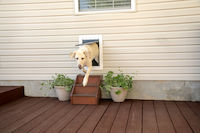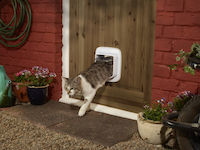Pet Doors provide your pet with a portal between two different environments, indoors and outdoors. This provides pets with a greater freedom of choice and extends the area over which they can self-exercise and explore. Pets benefit from increased exercise, fresh air and opportunities to investigate, fulfilling innate requirements and stimulating them psychologically.
Sometimes it is not a good idea to allow your pet unsupervised access into your garden. If your garden is not secure then there is a danger that your dog could escape and put itself and others in danger. If you live near busy roads you may decide to keep your cat indoors at all times to eliminate the chance of it becoming involved in a road traffic accident. If cats are kept indoors all of the time then owners have an obligation to provide them with a stimulating environment.
“Pet Doors provide pets with a greater freedom of choice”
 Undoubtedly your pet will benefit physically and psychologically from the freedom that a Pet Door can offer them. Pet Doors generally provide different degrees of freedom, depending if your pet is a cat or a dog. Cats generally use Pet Doors to access an area which may extend beyond the boundaries of their ‘territory’ or garden into their ‘home-range’ or neighbourhood. Dogs generally only use a Pet Door if their owners have secured the boundaries of their garden.
Undoubtedly your pet will benefit physically and psychologically from the freedom that a Pet Door can offer them. Pet Doors generally provide different degrees of freedom, depending if your pet is a cat or a dog. Cats generally use Pet Doors to access an area which may extend beyond the boundaries of their ‘territory’ or garden into their ‘home-range’ or neighbourhood. Dogs generally only use a Pet Door if their owners have secured the boundaries of their garden.
Acceptable behaviour outdoors is not necessarily acceptable behaviour indoors and it is important that our pets can differentiate between the two environments. Pets don’t learn to toilet outside, they just get into the habit of toileting outside
Pet Doors are pushed open by pets and do not require constant authorisation from the owner. This potentially allows the pet access to the garden whenever they want it, avoiding toileting accidents and therefore relieving the owner from constant supervision.
Many Pet Doors have settings that can control a pet’s exit or entrance inside a home. These can be manually set by the owner or could be activated by a device carried by the pet. Pet Doors can save energy too because they are small, generally positioned close to the floor and are only open for the instant that the pet is passing through them.
“Pets will benefit physically and psychologically from freedom”
 4-Way Locking Pet Doors have the ability to allow open, in only, out only or closed settings.
4-Way Locking Pet Doors have the ability to allow open, in only, out only or closed settings.
Some Pet Doors have closing panels which attach to the internal frame of the Pet Door, effectively sealing it. These are sometimes known as 2-Way Pet Doors.
Some selective entry Pet Doors also have 4-Way locking but the pets carry a device which authorises their entry. Selective entry systems may utilise magnetic, infra-red or R.F.I.D.* ‘keys’ attached to a collar. The most recent technology uses the cat’s own implanted microchip ID to grant them access through R.F.I.D.* Intruding cats are a significant cause of stress for resident cats. Selective entry cat flaps keep out unauthorised intruders, preserving the resident cat’s core territory within the home.
Pet Doors come in a variety of sizes, colours and profiles to fit into doors, windows or sliding glass doors. Tunnel extensions are available for some Pet Doors so that they can be fitted into walls.
With its advanced selective entry technology, our PetSafe® Microchip Cat Flap has been designed to allow your cat easy access to the outside world whilst keeping other troublesome cats and animals out of your house. Using radio frequency identification (RFID*) technology, it works by reading your cat’s unique microchip ID without the need for a collar or accessory. When your cat approaches the cat flap, the flap will respond by allowing only your cat to enter. The cat flap will remain locked and deny access to cats that are not programmed, wild animals, pests and strays. The cat flap is also designed with a convenient Manual 4-Way lock that allows you to control the access of your programmed cats.
“Busy owners can allow their pets freedom to exercise and explore”
 Once a Pet Door is fitted it is a good idea to allow your pet to gradually become familiar with it. Start by propping the door open or fitting the frame but leaving the door out. Tempt your pet through the opening using food treats, don’t force it or they may become scared of the door.
Once a Pet Door is fitted it is a good idea to allow your pet to gradually become familiar with it. Start by propping the door open or fitting the frame but leaving the door out. Tempt your pet through the opening using food treats, don’t force it or they may become scared of the door.
Once they are comfortable doing this, un-prop the door or fit the door into the frame. Before long your pet will be speeding through their own personal door.
"PetSafe® is committed to improving your pet’s quality of life through continued innovation in collaboration with animal professionals"

Written and developed in conjunction with
David Chamberlain BVetMed. MRCVS
Veterinary Consultant to PetSafe
![]() 0808 189 6130
0808 189 6130
Monday to Friday
08:30 to 17:00
Need help with a product?
Customer service is at the heart of everything we do. We're committed to giving you expert advice to ensure you always receive the very best.
To get the most protection out of your warranty, please register your product within 30 days here.
By registering and keeping your receipt, you will enjoy the product's full warranty and should you ever need to call our Customer Care Centre, we will be able to help you faster.
© 2025 Radio Systems Corporation All Rights Reserved. Privacy Statement Cookies Policy